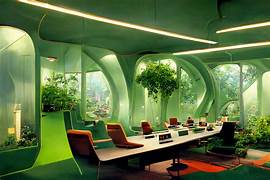In Hong Kong’s fast-paced business world, every square foot of office space carries strategic importance. A thoughtful interior design transforms workspace from backdrop into a performance engine. Studies show that employees working in better designed environments report measurable improvements — for instance, access to natural light and outdoor views has been linked with an 18% increase in productivity. As companies in Hong Kong adapt to hybrid-work norms and rising rent pressure, smart office design is becoming not just an aesthetic choice but a measurable business advantage.
From Decoration to Design Strategy
A decade ago, interior design was often treated as the final aesthetic layer. Today, it is a strategic driver that aligns physical environments with company goals. According to the World Green Building Council, workplaces with improved lighting, air quality and acoustics can raise productivity by up to 11%
In Hong Kong, one of the world’s most expensive office markets, this shift is essential. Workers in well-designed offices are 13% more productive and report higher job satisfaction. Partnering with Hong Kong office interior design experts who understand spatial constraints and design psychology helps companies transform limited floor area into a true competitive edge.
Designing for Focus and Flow
A productive office begins with understanding how people move and interact. Designers now talk about flow — the seamless transition between focus zones, collaboration areas and social spaces. In Hong Kong, where average usable office area per employee can fall below 100 square feet, precision is everything.
Research shows that workers in private or semi-enclosed offices report being “rarely distracted” 48% of the time, compared with only 19% in open-plan spaces. Lighting is another crucial factor: offices with abundant daylight and outdoor views can lift output by up to 12%. These figures demonstrate how data-driven design decisions — from acoustic zoning to ergonomic seating — can translate directly into bottom-line results.
The Human Element in Design
Designing for productivity also means designing for people. Surveys reveal that 65% of employees believe their productivity would increase if their workspace better reflected their ideal environment Biophilic features like plants and natural textures have been found to enhance focus and well-being, delivering up to a 15% uplift in productivity in field experiments.
For hybrid teams, flexible environments — lounge zones, quiet pods and modular layouts — now define the modern Hong Kong office, merging comfort with collaboration.
Sustainability and Well-Being
Sustainability complements productivity. According to the WorldGBC, healthy buildings yield strong business returns because small improvements in staff performance easily offset construction costs. Offices adopting green design measures — such as recycled materials, better ventilation, and energy-efficient lighting — can experience productivity increases of up to 20%
For Hong Kong companies committed to ESG principles, this connection between sustainability and performance turns responsible design into a tangible financial advantage.
Conclusion: The Productive Office Is Human-Centered
The most effective workplaces don’t just optimise space — they optimise people. By designing environments that support focus, creativity, and well-being, companies unlock sustainable productivity gains of 10% to 20%. In Hong Kong’s competitive business landscape, partnering with a professional Hong Kong office interior design company ensures every square foot works harder — creating offices that are not only beautiful, but measurably more productive.










